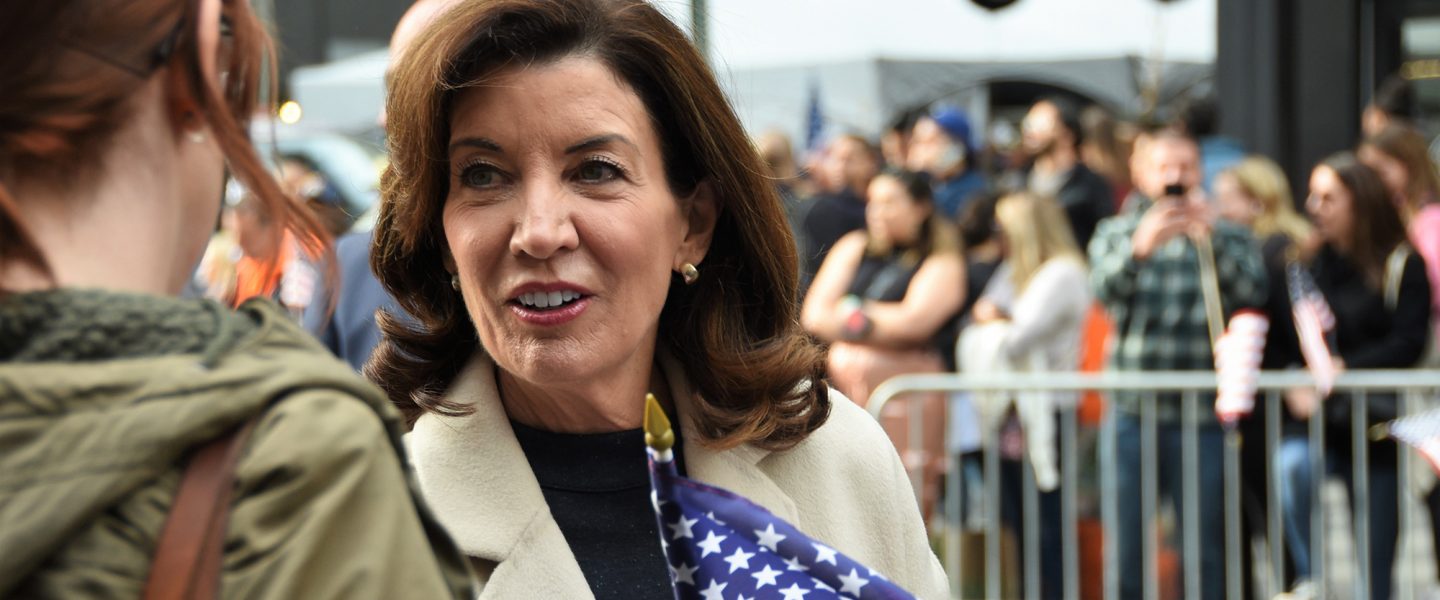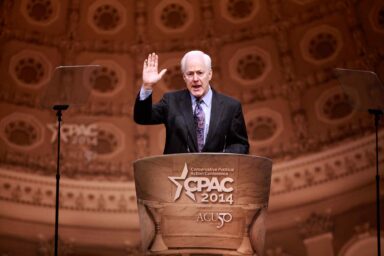The NY Democrats’ leftward shift may result in decisive national gains in 2024.
|
Listen To This Story
|
New York’s Democratic Gov. Kathy Hochul’s last appointment to the NY Court of Appeals, the state’s highest court, left egg on her face when the New York Senate, controlled by her own party, rejected her nominee.
Within the state and nationally, political allies wanted to know what a Democratic governor was doing appointing an anti-choice judge to the top court. Especially in the wake of the recent US Supreme Court Dobbs decision rejecting Roe v. Wade, the landmark case finding a constitutional basis for a woman’s right to choose, which had stood for 50 years.
Hochul’s nominee, Hector LaSalle, was rejected, despite several prominent Democrats coming out in support, including the current minority leader of the US House, Hakeem Jeffries (D-NY).
In response, it appears that Hochul — and, by extension, the New York Democratic Party machine — may be executing a leftward turn. Rowan Wilson, who was already serving as an associate judge on the Court of Appeals, replaced LaSalle as the nominee, and was confirmed in April as the first African American to be the court’s chief judge, the top judicial office in New York.
Wilson largely avoided blowback from progressives, despite some protests from the National Organization of Women in response to his recent decision dismissing a prosecution in a rape case. The reason the blowback was minimal could come down to political appreciation, as he took the Democrats’ side in an important battle: He dissented in a Court of Appeals decision that stripped the Legislature of the right to draw political district lines, siding with the Democratic Legislature in its decade-long redistricting battle with the rightward leaning court.
This issue is ongoing, as the governor is arguing before the court that the current Republican-friendly redistricting should not last the rest of the decade. That districting cost Democrats seats in the US House in the 2022 election and was seen as a decisive factor in the loss of their House majority, the political consequences of which have been seismic.
Wilson’s elevation from within the Court of Appeals created an additional vacancy. This was filled by Hochul’s appointment of Caitlin Halligan, who was not a judge and had no history of rulings and is therefore a judicial cipher. Halligan was selected out of private practice; she led the appellate department at the firm of Selendy Gay Elsberg. Formerly, she had been a solicitor general for New York.
Hochul’s nomination of a judge perceived to be conservative to an already rightward-leaning court — after that same court had severely damaged Democrats politically by rejecting their redistricting map and imposing one of its own that was favorable to Republicans — was a six-lane bridge too far.
Halligan is expected to give a 4 to 3 liberal majority to the Court, displacing the conservative majority that had previously held sway. This expectation is held despite her lack of judicial history and the traditional posture of strict political neutrality she presented during her confirmation hearings. Specifically she is expected to side with Democrats in the aforementioned restricting battle.
While Halligan is expected generally to side with the liberal wing of the court, there is a belief that the dual nomination of Wilson and Halligan was a political trade between the wings of the Democratic Party, giving liberals Wilson in exchange for Halligan for the more conservative wing. “This seems to be a bit of quid pro quo here,” said GOP Sen. Anthony Palumbo, the ranking member on the Senate Judiciary Committee.
Those looking for Halligan’s liberal credentials can point to her previous drawing of Republican ire. She was nominated by Barack Obama to the US Court of Appeals but her nomination was blocked by Republicans, who cited her suing of gun manufacturers as New York’s solicitor general. Those looking for conservative leanings note that she was working on behalf of Chevron when it targeted human rights lawyer Steven Donziger.
Progressive organizations had lobbied Hochul to nominate a public interest attorney or public defender to add diversity to the seven-member high court, which is mostly occupied by former corporate attorneys and prosecutors. Professor Vincent Bonventre of Albany Law School summed up the conflicting evidence this way:
The court in recent years has been much more conservative than in the past. I don’t think it will become a left-wing court, but will this court be more sympathetic to the rights of the accused? I think unquestionably. Workers’ rights? Unquestionably. Consumer rights? Unquestionably. The rights of people who’ve been harmed by others? Unquestionably.
It does seem that liberal Democrats managed to send a message to Hochul with the rejection of her initial rightward-leaning nominee. Hochul’s nomination of a judge perceived to be conservative to an already rightward-leaning court — a move very much in the pattern of her political mentor and predecessor, Andrew Cuomo — after that same court had severely damaged Democrats politically by rejecting their redistricting map and imposing one of its own that was favorable to Republicans, was a six-lane bridge too far.
Rather than trying the same brute force tactics again, Hochul found a way to compromise and give the progressive wing of her party a clearly liberal jurist (Wilson) — along with a more neutral, or at least more enigmatic, one (Halligan).
There were questions regarding the process by which Halligan was nominated, the vacancy created by promoting Wilson having allowed Hochul to pick two names from one list of nominees, which the New York GOP claimed was contrary to state law. Republicans threatened a lawsuit to prevent the confirmation, but failed to file it before the confirmation vote. At the time of this writing there has been no lawsuit filed.
If the governor hasn’t moved left with any real enthusiasm, she has at least demonstrated some pullback from her initial course of riding roughshod over that wing of the party.
Hochul’s State of the State agenda shows a similar mixed bag of priorities. There are progressive items on the agenda, such as a housing covenant and a plan for an annual increase of the minimum wage. But it also includes a crackdown on crime, traditionally a component of the conservative agenda.
Whether a product of ideological shift or mere diplomacy, the New York Democratic Party is moving fitfully leftward from the more conservative leanings of Andrew Cuomo. It is highly ironic to many observers that such a reliably blue state in national politics contrived to drive those politics hard red through the unexpected loss of crucial US House seats in 2022. However clunky, New York’s current leftward shift may well result in equally crucial Democratic gains come 2024.
Doug Ecks is a lawyer and writer. He holds a JD from the University of California, Hastings and a BA in philosophy from California State University, Long Beach, Phi Beta Kappa. He also writes and performs comedy as Doug X.





